| ________________
CM . . .
. Volume XXI Number 6. . . .October 10, 2014 
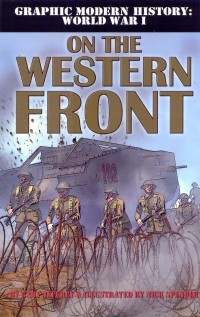 |
On the Western Front. (Graphic Modern History: World War I).
Gary Jeffrey. Illustrated by Nick Spender.
St. Catharines, ON: Crabtree, 2014.
48 pp., pbk., hc., & eBook, $11.95 (pbk.), $21.56 (RLB.).
ISBN 978-0-7787-0915-2 (pbk.), ISBN 978-0-7787-0909-1 (RLB.), ISBN 978-1-4271-9176-2 (eBook).
Subject Headings:
World War, 1914-1918-Campaigns-Western Front-Juvenile literature.
World War, 1914-1918-Campaigns-Western Front-Comic books, strips, etc.-Juvenile literature.
Graphic novels.
Grades 5-8 / Ages 10-13.
Review by Ian Stewart.
*** /4
|
| |
|
 |
War at Sea. (Graphic Modern History: World War I).
Gary Jeffrey. Illustrated by Terry Riley.
St. Catharines, ON: Crabtree, 2014.
48 pp., pbk., hc., & eBook, $11.95 (pbk.), $21.56 (RLB.).
ISBN 978-0-7787-0923-7 (pbk.), ISBN 978-0-7787-0913-8 (RLB.), ISBN 978-1-4271-9180-9 (eBook).
Subject Headings:
World War, 1914-1918-Naval operations-Juvenile literature.
World War, 1914-1918-Naval operations-Comic books, strips, etc.-Juvenile literature.
Graphic novels.
Grades 5-8 / Ages 10-13.
Review by Ian Stewart.
*** /4
|
| |
|
 |
War in the Air. (Graphic Modern History: World War I).
Gary Jeffrey. Illustrated by Nick Spender.
St. Catharines, ON: Crabtree, 2014.
48 pp., pbk., hc., & eBook, $11.95 (pbk.), $21.56 (RLB.).
ISBN 978-0-7787-0924-4 (pbk.), ISBN 978-0-7787-0914-5 (RLB.), ISBN 978-1-4271-9181-6 (eBook).
Subject Headings:
World War, 1914-1918-Aerial operations-Juvenile literature.
World War, 1914-1918-Aerial operations-Comic books, strips, etc.-Juvenile literature.
World War, 1914-1918-Campaigns-France-Juvenile literature.
World War, 1914-1918-Campaigns-France-Comic books, strips, etc-Juvenile literature.
Graphic novels.
Grades 5-8 / Ages 10-13.
Review by Ian Stewart.
*** /4
|
| |
|
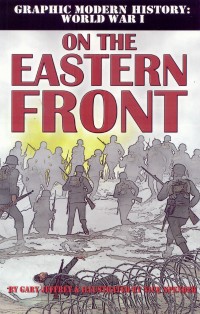 |
On the Eastern Front. (Graphic Modern History: World War I).
Gary Jeffrey. Illustrated by Nick Spender.
St. Catharines, ON: Crabtree, 2014.
48 pp., pbk., hc., & eBook, $11.95 (pbk.), $21.56 (RLB.).
ISBN 978-0-7787-0916-9 (pbk.), ISBN 978-0-7787-0910-7 (RLB.), ISBN 978-1-4271-9177-9 (eBook).
Subject Headings:
World War, 1914-1918-Campaigns-Eastern Front-Juvenile literature.
World War, 1914-1918-Campaigns-Eastern Front-Comic books, strips, etc.-Juvenile literature.
Graphic novels.
Grades 5-8 / Ages 10-13.
Review by Ian Stewart.
*** /4
|
| |
|
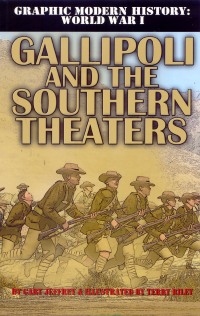 |
Gallipoli and the Southern Theaters. (Graphic Modern History: World War I).
Gary Jeffrey. Illustrated by Terry Riley.
St. Catharines, ON: Crabtree, 2014.
48 pp., pbk., hc., & eBook, $11.95 (pbk.), $21.56 (RLB.).
ISBN 978-0-7787-0917-6 (pbk.), ISBN 978-0-7787-0911-4 (RLB.), ISBN 978-1-4271-9178-6 (eBook).
Subject Headings:
World War, 1914-1918-Campaigns-Balkan Peninsula-Juvenile literature.
World War, 1914-1918-Campaigns-Balkan Peninsula-Comic books, strips, etc.-Juvenile literature.
World War, 1914-1918-Campaigns-Turkey-Gallipoli Peninsula-Juvenile literature.
World War, 1914-1918-Campaigns-Turkey-Gallipoli Peninsula-Comic books, strips, etc-Juvenile literature.
Graphic novels.
Grades 5-8 / Ages 10-13.
Review by Ian Stewart.
*** /4
|
| |
|
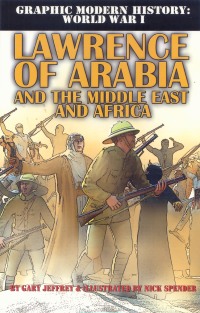 |
Lawrence of Arabia and the Middle East and Africa. On the Western Front. (Graphic Modern History: World War I).
Gary Jeffrey. Illustrated by Nick Spender.
St. Catharines, ON: Crabtree, 2014.
48 pp., pbk., hc., & eBook, $11.95 (pbk.), $21.56 (RLB.).
ISBN 978-0-7787-0918-3 (pbk.), ISBN 978-0-7787-0912-1 (RLB.), ISBN 978-1-4271-9179-3 (eBook).
Subject Headings:
Lawrence, T.E. (Thomas Edward), 1888-1935-Juvenile literature.
Lawrence, T.E. (Thomas Edward), 1888-1935-Comic books, strips, etc.-Juvenile literature.
World War, 1914-1918-Campaigns-Arab countries-Juvenile literature.
World War, 1914-1918-Campaigns-Arab countries-Comic books, strips, etc.-Juvenile literature.
Graphic novels.
Grades 5-8 / Ages 10-13.
Review by Ian Stewart.
*** /4
|
| |
|

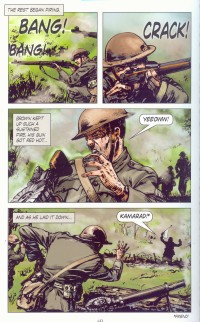 The six volumes of this series are an excellent complement to Crabtree’s “World War I: Remembering the Great War” series. That series focuses on the larger issues of politics and diplomacy whereas this one takes its audience into the heroism, the tragedy and the collective horrors soldiers, sailors and airman faced in the unprecedented global conflict. The colorfully illustrated graphic style format and striking prose help personalize the war and draw students into the lives of actual historical actors: Billy Bishop, Erwin Rommel, Manfred Von Richthofen, Ernst Junger, John Reed, T. E. Lawrence, along with many other heroes and villains. The six volumes of this series are an excellent complement to Crabtree’s “World War I: Remembering the Great War” series. That series focuses on the larger issues of politics and diplomacy whereas this one takes its audience into the heroism, the tragedy and the collective horrors soldiers, sailors and airman faced in the unprecedented global conflict. The colorfully illustrated graphic style format and striking prose help personalize the war and draw students into the lives of actual historical actors: Billy Bishop, Erwin Rommel, Manfred Von Richthofen, Ernst Junger, John Reed, T. E. Lawrence, along with many other heroes and villains.
Each book begins with a “prologue” which puts the stories into the conflict’s wider context. There are then three well-documented stories; however, the stories are not always only from “our” side--the Allied side—the “good guys” of World War I, and consequently students learn to see different perspectives to make their historical judgments. Each ends with an “epilogue” explaining how the issue developed as the war progressed. There is also a glossary and index.
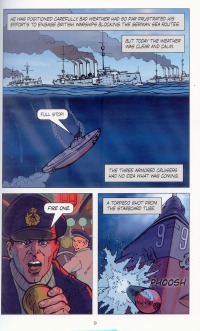 On the Western Front begins with the story of World War I’s origin and how the combatants’ armies came to be deadlocked in a four year war of attrition known as the “meat-grinder” of trench warfare. In the first story, readers learn about Ernst Junger, a German lieutenant, who was introduced to the horrors of modern warfare at the deadly 1916 Battle of the Somme. In the second, readers ride with a British tank crew led by Frank Mitchell who engaged in the first ever tank-to-tank battle in 1918. In the third, students come to see how chance and luck helped 13 lost Americans capture 150 Germans in the battle of Chateau Thierry. In the epilogue, students learn how new battle strategies and German military mistakes led to the war’s end in November 1918. On the Western Front begins with the story of World War I’s origin and how the combatants’ armies came to be deadlocked in a four year war of attrition known as the “meat-grinder” of trench warfare. In the first story, readers learn about Ernst Junger, a German lieutenant, who was introduced to the horrors of modern warfare at the deadly 1916 Battle of the Somme. In the second, readers ride with a British tank crew led by Frank Mitchell who engaged in the first ever tank-to-tank battle in 1918. In the third, students come to see how chance and luck helped 13 lost Americans capture 150 Germans in the battle of Chateau Thierry. In the epilogue, students learn how new battle strategies and German military mistakes led to the war’s end in November 1918.
At the beginning of the 20th century, Great Britain’s Royal Navy ruled the oceans; however, the Germany Empire began to compete with Britain by building their own “blue water” fleet. In War at Sea, students learn about Germany’s U-boat war against Allied shipping and the battles between mighty British Dreadnaughts and German battlecruisers. Story one demonstrates to students how dangerous a single submerged U-boat could be to British warships. In September 1914, U-9 emptied its torpedoes into three British ships leading to the loss of almost 1500 sailors. The most dramatic sea battle of World War I, the Battle of Jutland, May 1916, is the focus of story two when Germany’s and Britain’s battle fleets fought to take control of the northern sea lanes. The final story concerns the daring Zeebrugge Raid, April 1918, when a British battleship and troop of Royal Marines attacked a main Belgian ship channel to block German U-boats from reaching the North Sea.
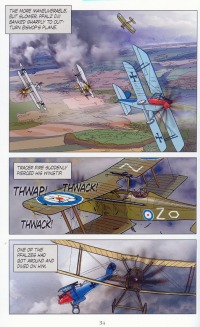 Air war was a new phenomenon in World War I. War in the Air teaches students that the “primitive and flimsy” aircraft that the combatants used in 1914 soon became sophisticated killing machines piloted by skilled airman. The first two stories in this book tell of the escapades of the war’s most prolific “aces”: Germany’s Baron Alfred Von Richthofen and Canada’s Billy Bishop. Eugene Jacques Bullard, the hero of story three, was the war’s first black pilot. He was an American flyer in the French air force, but, although Bullard was a brave airman, he was a victim of racial prejudice and forced out of the air force. The “aces” may have been the knights of the air but, as the epilogue shows, the airplanes’ practical value was as artillery spotters and bombers.
Air war was a new phenomenon in World War I. War in the Air teaches students that the “primitive and flimsy” aircraft that the combatants used in 1914 soon became sophisticated killing machines piloted by skilled airman. The first two stories in this book tell of the escapades of the war’s most prolific “aces”: Germany’s Baron Alfred Von Richthofen and Canada’s Billy Bishop. Eugene Jacques Bullard, the hero of story three, was the war’s first black pilot. He was an American flyer in the French air force, but, although Bullard was a brave airman, he was a victim of racial prejudice and forced out of the air force. The “aces” may have been the knights of the air but, as the epilogue shows, the airplanes’ practical value was as artillery spotters and bombers.
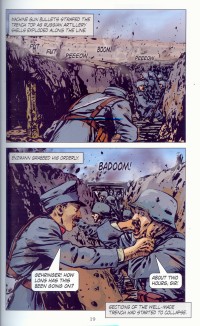 The war On the Eastern Front was fought in a larger geographic area than western Europe and was even bloodier; million man armies of Germany, Austria-Hungary battled Russian and Serbian armies. The Russian were defeated early by Germans in Prussia at the Battle of Tannenberg, but they held their own against the Austro-Hungarians. The war on this front carried on until Russia surrendered after the 1917 Bolshevik Revolution. Stories one and two describe the great offenses at Tannenberg and the Russia’s failed Brusilov Offensive. Story three tells the tale of the day Bolshevik revolutionaries stormed the Czar’s palace in Petrograd, October 1917, and the Communist Party’s takeover of Russia.
The war On the Eastern Front was fought in a larger geographic area than western Europe and was even bloodier; million man armies of Germany, Austria-Hungary battled Russian and Serbian armies. The Russian were defeated early by Germans in Prussia at the Battle of Tannenberg, but they held their own against the Austro-Hungarians. The war on this front carried on until Russia surrendered after the 1917 Bolshevik Revolution. Stories one and two describe the great offenses at Tannenberg and the Russia’s failed Brusilov Offensive. Story three tells the tale of the day Bolshevik revolutionaries stormed the Czar’s palace in Petrograd, October 1917, and the Communist Party’s takeover of Russia.
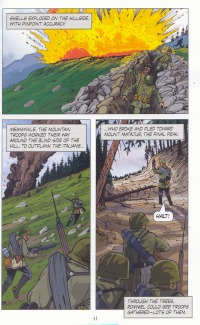 They were often known as “sideshows” because their importance to the overall war effort was not nearly as great as the battles being fought on the Eastern and Western Fronts. However, the two volumes Gallipoli and the Southern Fronts and Lawrence of Arabia and the Middle East and Africa demonstrate how WWI was worthy of its epithet, “global war”.
They were often known as “sideshows” because their importance to the overall war effort was not nearly as great as the battles being fought on the Eastern and Western Fronts. However, the two volumes Gallipoli and the Southern Fronts and Lawrence of Arabia and the Middle East and Africa demonstrate how WWI was worthy of its epithet, “global war”.
The Gallipoli and the Southern Fronts volume first takes readers into ferocious battles in Serbia and the story of an Austro-Hungarian soldier named Ernst Enzmann who was wounded and captured in 1914. Students then go to beachheads of Gallipoli, in 1915, where Australians fought valiantly against withering gunfire from the Turkish forces. The third story takes students to the mountains of Italy and the 1917 Battle of Caporetto where a German lieutenant named Erwin Rommel captured over 9000 Italian troops.
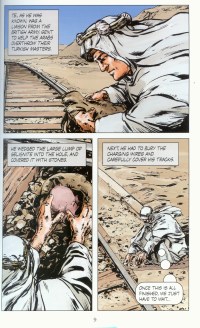 The Middle East and North Africa was important to the allied powers because of the vital Suez Canal and the oil fields. In the first story of Lawrence of Arabia and the Middle East and Africa , T. E. Lawrence, who became famous as Lawrence of Arabia, blows up a railroad train with the help of Arab tribesman fighting against the Ottoman Turks. In story two, readers join up with Australian cavalrymen who, in one of the last cavalry charges ever, ride against fortified troops in the desert town of Beersheba. The final episode tells the unbelievable story of a British regiment’s charge at Tel-El-Sheria, Palestine, led by a lieutenant colonel who kicked a soccer ball to inspire his men to move forward.
The Middle East and North Africa was important to the allied powers because of the vital Suez Canal and the oil fields. In the first story of Lawrence of Arabia and the Middle East and Africa , T. E. Lawrence, who became famous as Lawrence of Arabia, blows up a railroad train with the help of Arab tribesman fighting against the Ottoman Turks. In story two, readers join up with Australian cavalrymen who, in one of the last cavalry charges ever, ride against fortified troops in the desert town of Beersheba. The final episode tells the unbelievable story of a British regiment’s charge at Tel-El-Sheria, Palestine, led by a lieutenant colonel who kicked a soccer ball to inspire his men to move forward.
The graphic text and gory pictures are full of the sounds of rifle and machine gun fire and sights of gushing blood pouring out of wounded and dying soldiers, sailors and airman: PEEOW, ACK! ACK! ACK!, RRRRRRRRRRRRRR, FUT-FUT-FUT, DRURRUM, THAWP,THUNK, AAAGH!, AIEEE!, UURGH!. It’s not for everyone’s taste, but, realistically, these were the sights and sounds of World War I.
Recommended.
Ian Stewart teaches at Cecil Rhodes School in Winnipeg, MB.

To comment
on this title or this review, send mail to cm@umanitoba.ca.
Copyright © the Manitoba Library Association. Reproduction for personal
use is permitted only if this copyright notice is maintained. Any
other reproduction is prohibited without permission.
Next Review
| Table of Contents For This Issue - October 10, 2014.
CM Home | Back Issues
| Search
| CM Archive
| Profiles Archive
|






 The six volumes of this series are an excellent complement to Crabtree’s “World War I: Remembering the Great War” series. That series focuses on the larger issues of politics and diplomacy whereas this one takes its audience into the heroism, the tragedy and the collective horrors soldiers, sailors and airman faced in the unprecedented global conflict. The colorfully illustrated graphic style format and striking prose help personalize the war and draw students into the lives of actual historical actors: Billy Bishop, Erwin Rommel, Manfred Von Richthofen, Ernst Junger, John Reed, T. E. Lawrence, along with many other heroes and villains.
The six volumes of this series are an excellent complement to Crabtree’s “World War I: Remembering the Great War” series. That series focuses on the larger issues of politics and diplomacy whereas this one takes its audience into the heroism, the tragedy and the collective horrors soldiers, sailors and airman faced in the unprecedented global conflict. The colorfully illustrated graphic style format and striking prose help personalize the war and draw students into the lives of actual historical actors: Billy Bishop, Erwin Rommel, Manfred Von Richthofen, Ernst Junger, John Reed, T. E. Lawrence, along with many other heroes and villains.
 On the Western Front begins with the story of World War I’s origin and how the combatants’ armies came to be deadlocked in a four year war of attrition known as the “meat-grinder” of trench warfare. In the first story, readers learn about Ernst Junger, a German lieutenant, who was introduced to the horrors of modern warfare at the deadly 1916 Battle of the Somme. In the second, readers ride with a British tank crew led by Frank Mitchell who engaged in the first ever tank-to-tank battle in 1918. In the third, students come to see how chance and luck helped 13 lost Americans capture 150 Germans in the battle of Chateau Thierry. In the epilogue, students learn how new battle strategies and German military mistakes led to the war’s end in November 1918.
On the Western Front begins with the story of World War I’s origin and how the combatants’ armies came to be deadlocked in a four year war of attrition known as the “meat-grinder” of trench warfare. In the first story, readers learn about Ernst Junger, a German lieutenant, who was introduced to the horrors of modern warfare at the deadly 1916 Battle of the Somme. In the second, readers ride with a British tank crew led by Frank Mitchell who engaged in the first ever tank-to-tank battle in 1918. In the third, students come to see how chance and luck helped 13 lost Americans capture 150 Germans in the battle of Chateau Thierry. In the epilogue, students learn how new battle strategies and German military mistakes led to the war’s end in November 1918. Air war was a new phenomenon in World War I. War in the Air teaches students that the “primitive and flimsy” aircraft that the combatants used in 1914 soon became sophisticated killing machines piloted by skilled airman. The first two stories in this book tell of the escapades of the war’s most prolific “aces”: Germany’s Baron Alfred Von Richthofen and Canada’s Billy Bishop. Eugene Jacques Bullard, the hero of story three, was the war’s first black pilot. He was an American flyer in the French air force, but, although Bullard was a brave airman, he was a victim of racial prejudice and forced out of the air force. The “aces” may have been the knights of the air but, as the epilogue shows, the airplanes’ practical value was as artillery spotters and bombers.
Air war was a new phenomenon in World War I. War in the Air teaches students that the “primitive and flimsy” aircraft that the combatants used in 1914 soon became sophisticated killing machines piloted by skilled airman. The first two stories in this book tell of the escapades of the war’s most prolific “aces”: Germany’s Baron Alfred Von Richthofen and Canada’s Billy Bishop. Eugene Jacques Bullard, the hero of story three, was the war’s first black pilot. He was an American flyer in the French air force, but, although Bullard was a brave airman, he was a victim of racial prejudice and forced out of the air force. The “aces” may have been the knights of the air but, as the epilogue shows, the airplanes’ practical value was as artillery spotters and bombers.
 The war On the Eastern Front was fought in a larger geographic area than western Europe and was even bloodier; million man armies of Germany, Austria-Hungary battled Russian and Serbian armies. The Russian were defeated early by Germans in Prussia at the Battle of Tannenberg, but they held their own against the Austro-Hungarians. The war on this front carried on until Russia surrendered after the 1917 Bolshevik Revolution. Stories one and two describe the great offenses at Tannenberg and the Russia’s failed Brusilov Offensive. Story three tells the tale of the day Bolshevik revolutionaries stormed the Czar’s palace in Petrograd, October 1917, and the Communist Party’s takeover of Russia.
The war On the Eastern Front was fought in a larger geographic area than western Europe and was even bloodier; million man armies of Germany, Austria-Hungary battled Russian and Serbian armies. The Russian were defeated early by Germans in Prussia at the Battle of Tannenberg, but they held their own against the Austro-Hungarians. The war on this front carried on until Russia surrendered after the 1917 Bolshevik Revolution. Stories one and two describe the great offenses at Tannenberg and the Russia’s failed Brusilov Offensive. Story three tells the tale of the day Bolshevik revolutionaries stormed the Czar’s palace in Petrograd, October 1917, and the Communist Party’s takeover of Russia.  They were often known as “sideshows” because their importance to the overall war effort was not nearly as great as the battles being fought on the Eastern and Western Fronts. However, the two volumes Gallipoli and the Southern Fronts and Lawrence of Arabia and the Middle East and Africa demonstrate how WWI was worthy of its epithet, “global war”.
They were often known as “sideshows” because their importance to the overall war effort was not nearly as great as the battles being fought on the Eastern and Western Fronts. However, the two volumes Gallipoli and the Southern Fronts and Lawrence of Arabia and the Middle East and Africa demonstrate how WWI was worthy of its epithet, “global war”.
 The Middle East and North Africa was important to the allied powers because of the vital Suez Canal and the oil fields. In the first story of Lawrence of Arabia and the Middle East and Africa , T. E. Lawrence, who became famous as Lawrence of Arabia, blows up a railroad train with the help of Arab tribesman fighting against the Ottoman Turks. In story two, readers join up with Australian cavalrymen who, in one of the last cavalry charges ever, ride against fortified troops in the desert town of Beersheba. The final episode tells the unbelievable story of a British regiment’s charge at Tel-El-Sheria, Palestine, led by a lieutenant colonel who kicked a soccer ball to inspire his men to move forward.
The Middle East and North Africa was important to the allied powers because of the vital Suez Canal and the oil fields. In the first story of Lawrence of Arabia and the Middle East and Africa , T. E. Lawrence, who became famous as Lawrence of Arabia, blows up a railroad train with the help of Arab tribesman fighting against the Ottoman Turks. In story two, readers join up with Australian cavalrymen who, in one of the last cavalry charges ever, ride against fortified troops in the desert town of Beersheba. The final episode tells the unbelievable story of a British regiment’s charge at Tel-El-Sheria, Palestine, led by a lieutenant colonel who kicked a soccer ball to inspire his men to move forward.